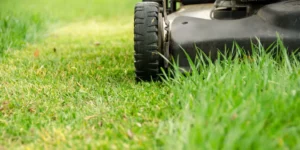As the days grow shorter and temperatures drop, many homeowners find themselves asking, “When should I stop mowing my lawn for the year?” This seemingly simple question has more nuance than one might think. Understanding the science behind grass growth and seasonal changes can help you make an informed decision, ensuring your lawn stays healthy and vibrant through the colder months.
Understanding Grass Growth Patterns
In the UK, most lawns are made up of cool season grasses such as perennial ryegrass and fescue. This type of grass thrives in cooler temperatures and is typically at its peak growth during spring and autumn. Thus, understanding their growth patterns is key to deciding when to halt mowing.

Seasonal Indicators for When to Stop Mowing
Temperature
Grass growth begins to slow down when the average daily temperatures consistently fall below 10°C. This typically occurs in late October and early November. When these temperatures are reached, you will notice that your lawn is growing more slowly, which is a natural signal that it’s time to reduce mowing frequency or stop altogether.
Grass Height
A good rule of thumb for lawn mowing is to keep your grass height between 3-5 cm during the growing season. As temperatures drop, consider raising your mowing height to around 5 cm; this helps protect the grass crowns from frost and winter stress. If your grass still appears to be growing, you can continue to mow, but be mindful not to remove more than one-third of the grass blade at any time.
Weather Conditions
Keep an eye on weather forecasts. A significant drop in temperature, particularly frost, is a clear indicator that the growth cycle is ending. Grass can become dormant in the cold months, and mowing frozen grass can damage it. If frost is expected, it’s best to cease mowing until conditions improve.
Signs It’s Time to Stop Mowing
In addition to temperature and growth patterns, there are other signs that indicate you might want to stop mowing for the year:
- Reduced Growth: If you notice that your lawn is not growing as quickly as it did during the peak summer months, it may be time to put the mower away.
- Frost and Dew: If you’re dealing with frequent frost or heavy morning dew, it’s wise to avoid mowing, as wet grass can lead to clumping and uneven cutting, potentially damaging the lawn.
Preparing Your Lawn for Winter
Once you’ve decided to stop mowing, it’s important to prepare your lawn for the winter months. Here are a few tips to keep your lawn healthy during dormancy:
- Final Mow: If you haven’t already, perform a final mow before winter. This last trim can keep your lawn looking neat and prevent the buildup of leaves and debris that can smother the grass.
- Aeration: Consider aerating your lawn as part of your winter preparation. Aeration helps improve drainage, reduces compaction, and allows nutrients, water, and air to reach the roots more effectively.
- Nutrition: Apply a winter application specifically designed for the cooler season. This will help strengthen the root system and provide essential nutrients as the grass prepares for the cold months ahead.
Conclusion
Understanding when to stop mowing your lawn is crucial for its long-term health and resilience. By paying attention to temperature changes, grass height, and specific signs of slow growth, you can make informed decisions that will support a lush, green lawn come spring.
With the right practices in place, your lawn will not only survive the winter but also thrive, ready to bounce back with vibrancy in the warmer months. If you have any further questions about lawn care or need assistance, feel free to contact us. Happy mowing!

 Established 2016
Established 2016



